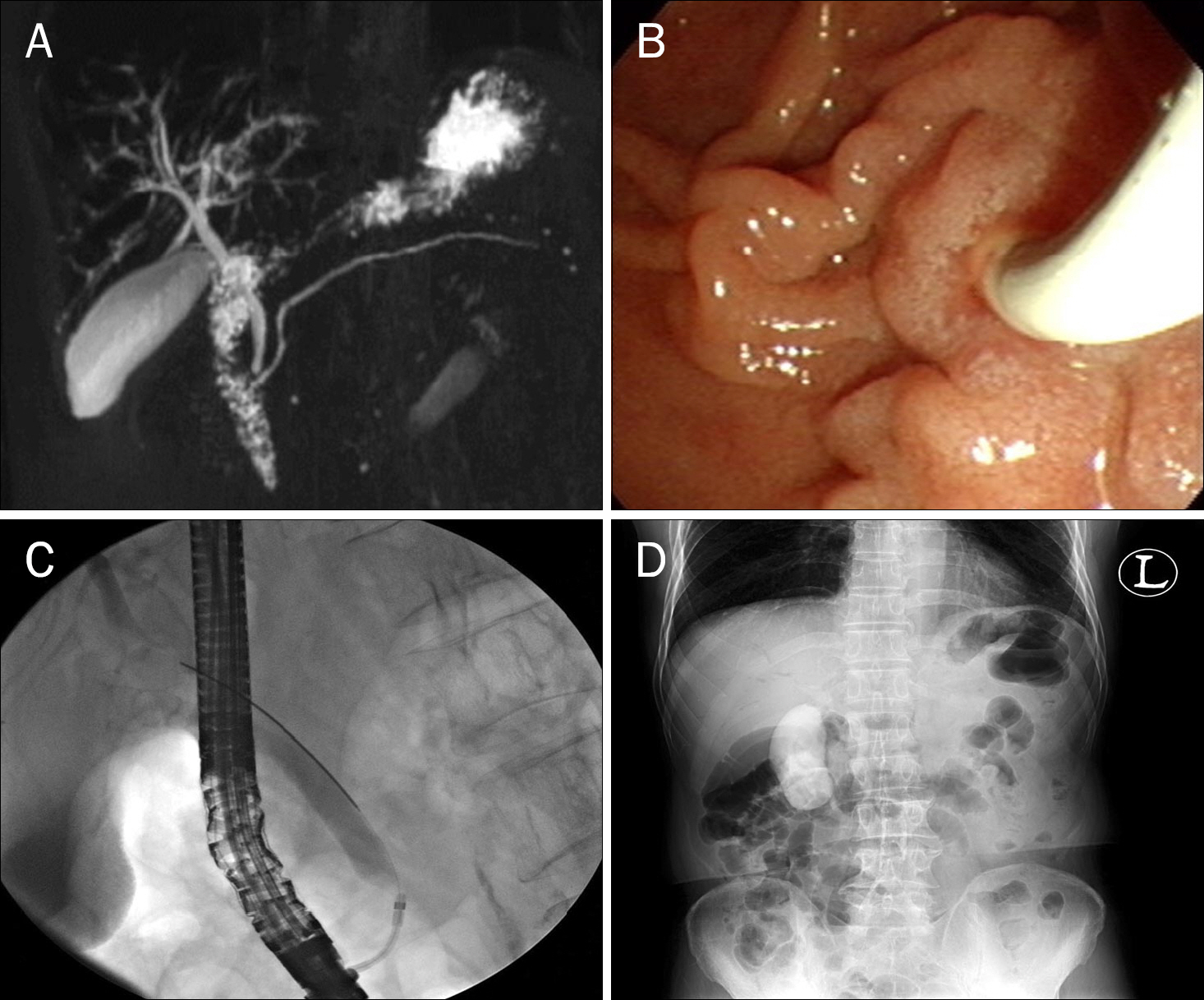Korean J Gastroenterol.
2015 Jun;65(6):370-374. 10.4166/kjg.2015.65.6.370.
Bedside Endoscopic Ultrasound-guided Transgastric Gallbladder Aspiration and Lavage in a High-risk Surgical Case Due to Acute Cholecystitis Accompanied by Multiorgan Failure
- Affiliations
-
- 1Department of Gastroenterology, Presbyterian Medical Center, Seonam University College of Medicine, Jeonju, Korea. jeja-1004@daum.net
- KMID: 2373240
- DOI: http://doi.org/10.4166/kjg.2015.65.6.370
Abstract
- Cholangitis and cholecystitis are intra-abdominal infections that show poor prognosis upon progression to sepsis and multiorgan failure. Administration of antibiotics with high antimicrobial susceptibility and removal of infected bile at the initial treatment are important. After undergoing ERCP for diagnostic purposes, a 58-year-old man developed acute cholangitis and cholecystitis accompanied by rhabdomyolysis, multi-organ failure, and severe sepsis. Broad-spectrum antibiotics with bedside endoscopic nasobiliary drainage were administered, but clinical symptoms did not improve. Therefore, bedside EUS-guided transgastric gallbladder aspiration and lavage was performed, resulting in successful treatment of the patient. We report the above described case along with a discussion of relevant literature.
Keyword
MeSH Terms
-
Cholangiopancreatography, Endoscopic Retrograde
Cholecystitis, Acute/complications/*diagnosis/diagnostic imaging
Drainage
Duodenoscopy
Endosonography
Escherichia coli/isolation & purification
Humans
Male
Middle Aged
Multiple Organ Failure/pathology
Rhabdomyolysis/complications/diagnosis
Sepsis/diagnosis/etiology/microbiology
Therapeutic Irrigation
Tomography, X-Ray Computed
Figure
Reference
-
References
1. Kullman E, Borch K, Lindström E, Anséhn S, Ihse I, Anderberg B. Bacteremia following diagnostic and therapeutic ERCP. Gastrointest Endosc. 1992; 38:444–449.
Article2. Loperfido S, Angelini G, Benedetti G, et al. Major early complications from diagnostic and therapeutic ERCP: a prospective multicenter study. Gastrointest Endosc. 1998; 48:1–10.
Article3. Masci E, Toti G, Mariani A, et al. Complications of diagnostic and therapeutic ERCP: a prospective multicenter study. Am J Gastroenterol. 2001; 96:417–423.
Article4. Devière J, Motte S, Dumonceau JM, Serruys E, Thys JP, Cremer M. Septicemia after endoscopic retrograde cholangiopancreatography. Endoscopy. 1990; 22:72–75.
Article5. Ertuğ rul I, Yüksel I, Parlak E, et al. Risk factors for endoscopic retrograde cholangiopancreatography-related cholangitis: a prospective study. Turk J Gastroenterol. 2009; 20:116–121.6. Yoshimoto H, Ikeda S, Tanaka M, Matsumoto S. Relationship of biliary pressure to cholangiovenous reflux during endoscopic retrograde balloon catheter cholangiography. Dig Dis Sci. 1989; 34:16–20.
Article7. Capoor MR, Nair D, Rajni , et al. Microflora of bile aspirates in patients with acute cholecystitis with or without cholelithiasis: a tropical experience. Braz J Infect Dis. 2008; 12:222–225.
Article8. Kim HY, Choi SO, Shin SJ, et al. Analysis of 250 cases of rhabdomyolysis. Kidney Res Clin Pract. 1994; 13:810–817.9. Blanco JR, Zabalza M, Salcedo J, Echeverria L, García A, Vallejo M. Rhabdomyolysis of infectious and noninfectious causes. South Med J. 2002; 95:542–544.
Article10. Dudley HAF. The biliary tract. Bailey H, Dudley HAF, editors. Hamilton Bailey's emergency surgery. 11th ed.Bristol: Wright;1986. p. 312–321.11. Ito K, Fujita N, Noda Y, et al. The usefulness of percutaneous cholecystostomy for acute cholecystitis. JJBA. 2008; 22:632–637.12. Nakatsu T, Okada H, Saito K, et al. Endoscopic transpapillary gallbladder drainage (ETGBD) for the treatment of acute cholecystitis. J Hepatobiliary Pancreat Surg. 1997; 4:31–35.
Article13. Ogawa O, Yoshikumi H, Maruoka N, et al. Predicting the success of endoscopic transpapillary gallbladder drainage for patients with acute cholecystitis during pretreatment evaluation. Can J Gastroenterol. 2008; 22:681–685.
Article14. Song TJ, Park do H, Eum JB, et al. EUS-guided cholecystoenter-ostomy with single-step placement of a 7F double-pigtail plastic stent in patients who are unsuitable for cholecystectomy: a pilot study (with video). Gastrointest Endosc. 2010; 71:634–640.
Article15. Jang JW, Lee SS, Park do H, Seo DW, Lee SK, Kim MH. Feasibility and safety of EUS-guided transgastric/transduodenal gallbladder drainage with single-step placement of a modified covered self-expandable metal stent in patients unsuitable for cholecystectomy. Gastrointest Endosc. 2011; 74:176–181.
Article16. Salim AS. Percutaneous aspiration, lavage and antibiotic instillation. New approach in the management of acute calculous cholecystitis. HPB Surg. 1991; 3:167–175.
Article17. Ito K, Fujita N, Noda Y, et al. Percutaneous cholecystostomy versus gallbladder aspiration for acute cholecystitis: a prospective randomized controlled trial. Am J Roentgenol. 2004; 183:193–196.
Article18. Tsutsui K, Uchida N, Hirabayashi S, et al. Usefulness of single and repetitive percutaneous transhepatic gallbladder aspiration for the treatment of acute cholecystitis. J Gastroenterol. 2007; 42:583–588.
Article19. Jang JW, Lee SS, Song TJ, et al. Endoscopic ultrasound-guided transmural and percutaneous transhepatic gallbladder drainage are comparable for acute cholecystitis. Gastroenterology. 2012; 142:805–811.
Article20. Burke DR, Lewis CA, Cardella JF, et al. Society of Interventional Radiology Standards of Practice Committee. Quality improvement guidelines for percutaneous transhepatic cholangiography and biliary drainage. J Vasc Interv Radiol. 2003; 14:S243–S246.
Article
- Full Text Links
- Actions
-
Cited
- CITED
-
- Close
- Share
- Similar articles
-
- Endoscopic Transpapillary Gallbladder Stenting for Acute Cholecystitis in a Patient with Metastatic Pancreatic Cancer
- Single-pigtail plastic stent made from endoscopic nasobiliary drainage tubes in endoscopic ultrasound-guided gallbladder drainage: a retrospective case series
- Current Status of Endoscopic Gallbladder Drainage
- Practical Approaches for High-Risk Surgical Patients with Acute Cholecystitis: The Percutaneous Approach versus Endoscopic Alternatives
- Endoscopic Gallbladder Drainage for Acute Cholecystitis



